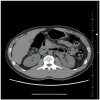Opportunistic Detection of Chronic Kidney Disease Using CT-Based Measurements of Kidney Volume and Perirenal Fat
- PMID: 40869714
- PMCID: PMC12387138
- DOI: 10.3390/jcm14165888
Opportunistic Detection of Chronic Kidney Disease Using CT-Based Measurements of Kidney Volume and Perirenal Fat
Abstract
Background/Objectives: Chronic kidney disease (CKD) is a prevalent condition with many cases remaining undiagnosed, although early detection is essential. Adipose tissue distribution-particularly perirenal fat thickness (PrFT)-has recently been linked to renal pathophysiology. This study assessed the association between CT-derived parameters of fat distribution and kidney morphology with CKD. Materials and Methods: This retrospective study included 237 patients (117 subjects, 120 controls) who underwent abdominal CT and had serum creatinine data. The dataset was randomly split (70% training, 30% test) to develop and evaluate a logistic regression model. CKD was defined as estimated Glomerular Filtration Rate (eGFR) < 60 mL/min/1.73 m2. PrFT was measured as the distance from the posterior renal capsule to the posterior abdominal wall; renal hilum fat was segmented using a -195 to -45 HU range. Additional parameters (measured using automated segmentation tools) included kidney volume (KV), visceral/subcutaneous fat areas, skeletal muscle area and attenuation, and liver attenuation. Bilateral measurements were averaged. Results: KV (OR = 0.249, 95% CI: 0.146-0.422, p < 0.001) and PrFT (2nd tercile: OR = 7.720, 95% CI: 2.860-20.839; 3rd tercile: OR = 16.892, 95% CI: 5.727-49.822; both p < 0.001) were identified as independent predictors of CKD. These variables were used to construct a simplified model, which demonstrated moderate clinical applicability (AUC = 0.894) when evaluated on the test subset. Conclusions: KV and PrFT emerged as independent predictors of CKD, forming the basis of a simplified model with potential for opportunistic clinical application. This approach may facilitate earlier detection of CKD in patients undergoing CT imaging for unrelated clinical reasons. These imaging parameters are not intended to replace serum creatinine or eGFR but may serve as complementary predictors in specific clinical contexts.
Keywords: abdominal fat; chronic kidney disease; computed tomography; imaging biomarkers; kidney volume; opportunistic screening; perirenal fat; renal hilum attenuation; renal hilum fat; visceral fat.
Conflict of interest statement
The authors declare no conflicts of interest.
Figures






Similar articles
-
Prescription of Controlled Substances: Benefits and Risks.2025 Jul 6. In: StatPearls [Internet]. Treasure Island (FL): StatPearls Publishing; 2025 Jan–. 2025 Jul 6. In: StatPearls [Internet]. Treasure Island (FL): StatPearls Publishing; 2025 Jan–. PMID: 30726003 Free Books & Documents.
-
Perirenal fat thickness may be a significant predictor of prognosis and postoperative renal function in renal cancer surgery patients.Sci Rep. 2025 Sep 2;15(1):32341. doi: 10.1038/s41598-025-17865-7. Sci Rep. 2025. PMID: 40897796 Free PMC article.
-
Angiotensin-converting enzyme inhibitors and angiotensin receptor blockers for adults with early (stage 1 to 3) non-diabetic chronic kidney disease.Cochrane Database Syst Rev. 2011 Oct 5;(10):CD007751. doi: 10.1002/14651858.CD007751.pub2. Cochrane Database Syst Rev. 2011. Update in: Cochrane Database Syst Rev. 2023 Jul 19;7:CD007751. doi: 10.1002/14651858.CD007751.pub3. PMID: 21975774 Updated.
-
Early referral strategies for management of people with markers of renal disease: a systematic review of the evidence of clinical effectiveness, cost-effectiveness and economic analysis.Health Technol Assess. 2010 Apr;14(21):1-184. doi: 10.3310/hta14210. Health Technol Assess. 2010. PMID: 20441712
-
Synbiotics, prebiotics and probiotics for people with chronic kidney disease.Cochrane Database Syst Rev. 2023 Oct 23;10(10):CD013631. doi: 10.1002/14651858.CD013631.pub2. Cochrane Database Syst Rev. 2023. PMID: 37870148 Free PMC article.
References
-
- Francis A., Harhay M.N., Ong A.C.M., Tummalapalli S.L., Ortiz A., Fogo A.B., Fliser D., Roy-Chaudhury P., Fontana M., Nangaku M., et al. Chronic kidney disease and the global public health agenda: An international consensus. Nat. Rev. Nephrol. 2024;20:473–485. doi: 10.1038/s41581-024-00820-6. - DOI - PubMed
Grants and funding
LinkOut - more resources
Full Text Sources
Research Materials
Miscellaneous

